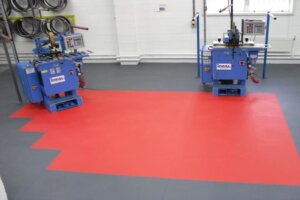It is necessary to note such important parameters as resistance to static and dynamic loadings. The flooring warehouse should easily withstand the movement of transport and people, the pressure of racks with the goods, falling of heavy objects.
It is important that the surface is resistant to scratches, abrasive wear, and other negative factors. Self-leveling floors for warehouses are often exposed to acids, alkalis, salts, fuels, and lubricants. Thus, the industrial flooring must be resistant to aggressive chemical environments.
Requirements for the industrial floor for warehouses:
- Durability;
- Maintainability;
- No dust;
- Hygiene;
- Water-resistance;
- Fire Security;
- Cost-effectiveness.
Bulk flooring fully meets all these requirements. Manufacturers of polymer self-leveling floors for warehouses use modern technologies and materials. Coatings can be divided into three major groups depending on the components used.
For example, methyl methacrylic coatings are ideal if the increased load resistance is important.
The polyurethane mixture penetrates into the concrete base to a depth of 2 to 6 millimeters, which not only strengthens the base but also provides excellent sealing and dedusting.
The epoxy mixture, in turn, is much cheaper. Therefore, we, the company “Gym and Garage Floor” have prepared for you the most interesting option in terms of strength and price, which has already been tried in many warehouses in Gauteng
Depends on the conditions specific to a particular warehouse.
First, we impregnate the concrete base with polyurethane or epoxy primer by 3-5 mm, and then cover it with the top layer of epoxy mixture, respectively, for a much lower price than a polyurethane floor, you get a high-strength industrial coating for the warehouse.
When choosing a bulk floor for a warehouse, you make the right decision, the practicality of which can be seen many times. Industrial floors for warehouses serve for one and a half decades and more. If necessary, they are easily updated, restoring a neat, aesthetically pleasing appearance and performance.
The stages can be divided into so many parts:
- Grinding of the top, usually loose, a layer of a covering.
- Detection of cracks and selection of low-quality concrete from them
- Earning of pits and cracks with epoxy repair mix
- Surface priming.
- Surface grinding of the coating for better adhesion.
- Spackling of a surface.
- Grinding for finishing leveling of a surface
- Primary color.
- Secondary color
As for the installation of the floor in the warehouse, this operation will not take much time, taking into account all the stages, an area of 100m2-300 m2 will be ready industrial floor for the warehouse in 10-14 days. In this way, the premises can be quickly put into operation without harming business processes.
